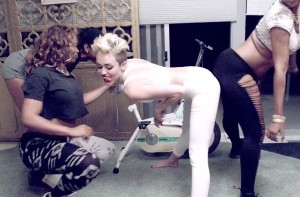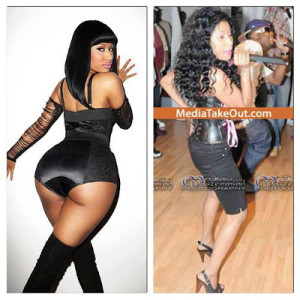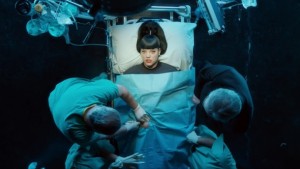We all know the song “Baby Got Back” by Sir Mix A Lot, and I’m sure most of us can sing to it too, but what is it about that song that we like? Is it the fun beats? Is it the funny lyrics? Or is it the topic of the song in general? If you think that we love the song because of its topic of specifically talking about a woman’s body in such a comical way, well you may be right. But it isn’t the only song that specifically talks about women’s bodies; there are many songs that talk about women’s butts. The implications of this however is that since these songs talk of a specific part of a woman, and not her as a whole, it dehumanizes, objectifies and even trivializes women’s bodies.
Music
Music is a large part of the body image problem; almost all genres of music portray images of body types, and most are also misogynistic in some way. This creates the idea that women are objects for the male desire. Objectification is not only seen in the lyrics, but the music videos themselves by putting women in positions where their body is often seen more than their face. The specific topic being looked at is the objectification of women’s bodies through the focus of music’s obsession with women’s butts, an eventually implication that women in the real world have to face because of these images portrayed.
Pop Music. Pop music is a genre that talks about butts, recently Miley Cyrus (2013) in her song and music video “We Can’t Stop” talk about doing what they want; and that includes dancing. She says “to my home girls here with the big butt; shaking it like we at a strip club” shows that they need to shake their ass to gain attention and to have fun. She also shows a specific importance to women with big butts dancing in her video.

Miley twerking with her “home girls with the big butts”
Source
In “Blurred Lines” (2013), Robin Thicke and Pharrell Williams sing about how they are going to “tear your ass in two” referencing that having a butt and using it is an important aspect of a woman. Robin Thicke also says in his song “Give It 2 U” (2013) that he like what’s on her back and that she should shake it he specifically focuses that he likes that part of a woman’s body and not her as a whole.
Katy Perry in her documentary (2012) comments about a costume where she has an ass like Nikki Minaj, showing that she wishes she has an ass like Nikki, but only through the costume will she be able to have an ass like hers. This also shows a bit of white versus black bodies and how Katy can “play” with her body image by going back and forth with a big and small ass and Nikki Minaj has her large ass, which she had surgery to have, that is hard to “play.”
Seanbaby from Cracked.com has created a system that evaluates the amount of references to the butt and the length of a song to create the “booty per second” system that he has implemented on a few songs (2009). The song “My Humps” talks about butts 57 times in the 3:52 minutes of the song averaging .25 booty per second (Seanbaby). “My Humps” by Black Eyed Peas is a wonderful example because every four seconds, they reference the butt.
Country Music. “Honky Tonk Badonkadonk” by Trace Adkins talks about women with big behinds on many occasions in this song. Some are “you can’t blame her for what her mama gave her,” “how’d she even get them britches on,” “workin’ that money-maker,” and “we hate to see her go, but love to watch her leave.” The only lyric that is for women in this song is that “you can look but you can’t touch” but this implies that all the men are still staring at her.
“Tight Fittin’ Jeans” by Conway Twitty, he sings about a woman who is glorified by her wearing tight fitted jean. This is obviously about her ass and that he was so enraptured by her form that it was all he could talk about. He however only dances with her and not anything else physical, but he still dreams of her, and her tight jeans.
“Venom Wearin’ Denim” by Junior Brown talks about a woman who only needs tight jeans to be able to get a man. This focuses on the male focus on her butt, and that since she has a really great one, which is all she needs. This song also refers to her in a snake like way by saying she’s venomous, she hisses, there is no antidote for her, and she coils up besides men. She is dangerous because she has a good body and that she is dangerous to men because of her body.
Rap Music. Rap music is the cream of the crop when it comes to glorifying women’s assets. Some songs are “Donk” by Soujla Boy Tell’em, “Too Much Booty in the Pants” by 2 Live Crew, “Da Butt” by EU, “Whistle While you Twurk” by the Ying Yang Twins, “Ms. Fat Booty” by Mos Def, “Dazzey Duks” by Duice, “Big Ole Butt” by LL Cool J, and “Big Bottom” by Spinal Tap. All the titles even denote that they are singing about women’s behinds. And most are in the most objectifying and dehumanizing way. Some even reference women only by her butt. This shows the significance of a butt, specifically a big butt in rap culture.
“Bubble Butt” by Major Lazer has res-parked the conversation that Sir Mix a Lot started in 1992 when he had the song “Baby Got Back” about Eurocentric beauty (“Stats”). “Bubble Butt” is visualized by starting on skinny white women at a party, and then a literal giant black woman with cut-outs in the back of her pants flies through the air and lands outside from where the white women are partying. She then starts laughing and hoses come out of her mouth and go into the white women’s asses where they then inflate to anatomically incorrect largeness. A wild party with many African Americans starts to happen around the white women and they start dancing with African American women.

Flying woman in Major Lazer’s song “Bubble Butt.”
Source
This song not only shows rap music’s obsession with the butt, but it also shows racial differences within body size. This song brings the debate about butt size out into the open and about the racial differences between their assets (“Stats”). This shows that not just African American women are concerned about their butt size, but women of every race are not concerned about their butt.
“Ms. New Booty” by Bubba Sparxx refers to the booty 73 times in the 4:39 minute song averaging 2.6 booty per second (Seanbaby). This song is about a man looking for a new woman with a big butt. This song also exemplifies the use and abuse of women by finding new women and being able to toss them aside when they are done with them.
The singer R&B K.Michelle recently admitted to getting a butt lift, but swears that she doesn’t get injections (Natasha). This singer, who used to be heavier before losing weight, had gotten this surgery to enhance her behind. Because of getting fat taken out of her midsection, her weight loss and her butt lift, her booty looks even bigger and more pronounced (Natasha). This shows that even women of the genre are changing their bodies to attain the perfect butt.
Nikki Minaj is known not only for her music, but also her big butt that she likes to flaunt. In her song “Dance (A$$)” she repeatedly says “ass” and talks about dancing and shaking her ass. Robinson says in his article that Nikki is quiet on whether she got ass implants, but one of Nikki’s close friends in an interview said that they were fake. Minaj’s famous ass is also a figment of the industry’s body image views on big asses.

Nikki Minaj’s picture, before and after her surgery.
Source
Healthy bodies
All this talk about what music and images of women’s butts brings a real question to mind; what is a healthy butt? What does a big butt mean? Why do men obsess over them? What do women think of their bodies and these images of bodies? Well many experts think that liking big butts is an evolutionary trait that has been instilled in men. Women also have come to appreciate big butts.
The fuller lower body is seen as attractive because of the theory that it suggests health and fertility says Ph.D. Viren Swami (YouBeauty). The fuller lower body, meaning butts and thighs, shows that women are more able to bear healthy children and survive childbirth. Brown writes that “men look at attractive women because attractiveness means the women are healthy, an evolutionary advantage.”Men therefore are attracted biologically to the need to reproduce and bigger butts show that a woman has a better opportunity to pass on his genes.
Men however aren’t always interested in just big butts; they are often a “boob man” or an “ass man.” Men everywhere aren’t interested in big butts, but since larger behinds are gender specific, it is something men look at since they don’t have one (YouBeauty). Since men do not have the same type of big butt, or even boobs for the matter, it is often a part of a woman’s body in which men become transfixed. It’s the mere fact that it is foreign to them that they often talk or obsess over something like a woman’s butt.
Women: bodies and music
Music has been known to talk about women’s bodies and has been doing so for as long music has been around. Music recently however, and I talk the last hundred or so years, has been specifically talking about women’s bodies and directly talking about them and what they should be like; music has set a framework for women and their “ideal body type.” This can cause major damages to women’s physical bodies and their self-esteem and other implications (what are the other implications) because of that. Women, however, take these ideal body types, which not many women actually possess, and take them to heart. This causes damage to women everywhere.
It is widely known that people, women especially, have a hard time with media and their body images. Media constantly throws images of “perfect bodies” and images of the perfect form at people. This causes a distorted view of bodies, causing an array of problems. “Approximately 91 percent of women are unhappy with their bodies and resort to dieting to achieve their ideal body shape. Unfortunately, only 5 percent of women naturally possess the body type often portrayed by Americans in the media” (Do Something).
It’s true our media is extremely skewed when it comes to body types. The average size of American women today is the size 14 (Crow). This is a drastic change to the visuals we see of size 2 supermodels and actresses that bombard us every day. Models however weigh 23% less than an average woman and size 6 is considered plus size (Lovett). This effects how women treat their bodies, emotionally and physically.
Because of these images, many women have eating disorders and other disorders to try and conform their body to these kinds of standards. This publicity of the ideal body image causes women to lower their approval of their own attractiveness (Women in Ads). Because of this image, more than 30% of women and 20% of men consider plastic surgery; this is consistent across gender, age, marital status and race (Do Something). This is a truly shocking since there is often no need for treatment or reconstruction, there are just skewed images of self.
I asked several women about how they viewed their bodies, especially their butt. Many said how they didn’t like their butt or how it’s not how it’s supposed to be. Some talked about why their bodies aren’t the ideal and others said the source of their specific body image problems.
Stephanie, and undergraduate at this university and an avid music lover, said that her boobs, butt and waist stand out the most; you need to have thin thighs and a small waist to be able to have the ideal body. She specifically talked about the Sir Mix A Lot Song “Baby Got Back” when referencing her big butt and thin waist dilemma. She also says that music videos focus on very specific parts on women’s bodies. She comments that butts are all you see, besides big boobs and really tight clothes showing off their bodies, specifically their butts and waist. Stephanie listens to Tyga and Lil’ Wayne, and she says that they glorify women’s vaginas and therefore their butt. In the end she says that this “Makes me feel that I need to be that way, even though I’m not.”
Bailey, another undergraduate at this university, says that she tries not to listen to rap music because of the way it makes her feel. She also says that music, and for her specifically images that go along with them, make her feel inadequate and that she should be that way that they look also. “I think it’s bad that music, rap music in particular, focuses on women’s bodies in an objectifying way.” She tries to avoid rap, and has looked to other genres for her musical interests.
Sarah, an undergraduate, says that curves are healthy and that it shows fertility. She is proud of what she has but is also driven to look a certain way by the media that has projected. Her three main factors in body image are 1) Barbie, interestingly enough Nikki Minaj calls herself “Black Barbie” and has a fairly large derriere, 2) anime [cartoon female representation], and 3) rap music. She also comments that men look at butt and boobs because they don’t have them and they have to obsess about them because it is so foreign to them.
A celebrity, Kim, Kardashian, who is known for her curves, had x-rays taken of her butt to prove that it was real. “I’ve said numerous times ‘I haven’t had plastic surgery, I haven’t had butt implants” (Daily Mail). Kim is a “role model” of the female form for some, causing people to think that they can have the body type that she possesses. Women, when they cannot possess this body type, they resort to other measures.
When I did a Google search I typed “how to get a” and bigger butt was the second option. Even Googling “big” the next two options are about bigger butts. This shows that women are looking at ways to enhance their derriere. There are even work out programs designed around getting a larger behind, but unfortunately long lasting work out routines take too much time for some women. “Popular culture has gone from accepting curves to obsessing over them” (Crocker, 2012). There are some evasive and non-evasive ways to get a bigger booty. But many people have undergone surgery to get a bigger behind. Many women are now undergoing illegal and dangerous surgeries and injections to create their perfect body.

This is an advertisement for a website promoting their butt exercises that woman can use.
Source
One non-evasive way to get that “perfect booty” is an invention called the Booty Pop. This is underwear that has pads on the back to create the illusion of the perfect butt. This is like stuffing a bra with tissues, instead, its underwear. This is one of the lesser evils of enhancing the butt. The exercise routines are also in the non-evasive category.
But immediate dermal effects are what most women want. In Florida, A woman went through an illegal gluteus augmentation, which is similar to Botox and increases the butt size, but died from this illegal practice (Sanchez & Perez). Glut injections are not a rarely occurring practice, many women undergo illegal injections to try and attain the perfect butt. The Florida woman however paid the price for her injections. She died from a lung embolism hours after her second treatment which she complained that she “felt dizzy” (Sanchez & Perez). Like this Florida woman, many of these procedures that have gone wrong in such a way as to result in infection or horrible deformities, amputation is the only option to save a woman’s life (Crocker).
Another woman from Los Angeles underwent what she thought was silicone injections that have left a devastating effect on her body. What she really got from an unlicensed practitioner was bathroom sealant injected into her behind (De Lacey). This caused her such intense pain that the doctors had to amputate her butt, but after this surgery, it became infected and she was told she only had 24 hours to live (De Lacy). She was put into a coma; she woke up two months later and was told she had undergone 27 operations that included the butt amputation, a quadruple lower arm and leg amputation (De Lacey). In this case, the woman lived, but many are not this lucky.
Injections are often illegal and not done by trained medical professionals. People looking for the perfect butt are stopping at nothing to get it. Illegal butt injections are on the rise, especially in young African American women (Crocker). But not just African American women are getting these injections, it is just more of a cultural norm that African Americans have bigger behinds and they are trying to live up to this unreasonable standard. This isn’t race specific, but the “frame-work” or a curvy body is there; “’They’re curvy on the bottom by nature,’ said Dr. Lisa Ginn, an African-American dermatologist. ‘Now something I was born with that, for years, I was told was not the ideal body type, men love. Everybody loves it’” (Crocker).
Conclusion
In conclusion, butts are a topic that are widely discussed within many realms, between men, women, in music, and in visuals, but one thing is consistent and that is that almost everyone who is talking about butts are obsessed. Obsession is rooted within the misogynistic views of men over women and their need to use as many women as possible. Past example is Bubba Sparxx and the song “Ms. New Booty.” Rap music, as said in the past, is the main culprit of these misogynistic lyrics and ideas with a few exceptions of a few other music genres.
Biological factors are also included in our obsession over butts. Larger behinds show healthier women have a better chance at having babies, surviving childbirth, and passing on genes. This causes the general male obsession over butts and why women want to have bigger butts. They want bigger butts to be able to attract men and gain the attention of a partner, which will eventually lead to childbirth.
The implications of this are that women are drastically changing their bodies in dangerous ways to try and conform to this standard of beauty to the point of drastic modification that can result in death. Because of these messages to have a certain body coming from many different forms of media and even potential partners, women feel inadequate and change themselves to fit these forms of beauty.
Other implications besides the dangerous changes to women’s bodies that some are putting themselves through, many women also start to have eating disorders and body disfigurement disorders that cause them to see a different reality than the one that is right in front of them. This in turn, can cause mental issues that can lead to depression and suicidal thoughts. The image of their body is so important to some women that they would rather die than have the body that they were born with.
Women can take this new view of beauty and use it to their advantage. This idea of beauty is different than the traditional “white” beauty of the thin all over body type. It shows that differences in body types can be beautiful and women can use that by proudly standing up and saying their body type is beautiful. This break from that beauty type can pave the way for claiming beauty, especially in media, for the wide array of body types that women possess.
One female role model is Lily Allen, an English recording artist who uses this objectification in her new song and music video “Hard Out Here”. In this video, she is on an operating table getting liposuction; she is being talked about by the “agent” and “the surgeon” as they are standing above her. Her agent says “how can somebody let themselves get like this” and the surgeon also remarks “lack of self-discipline I suppose.” That’s when she interjects “Um, I had two babies.” The surgeon ignores her and says to the agent “a lot of women do this after they have children, they just basically let go.” Where the agent says “really? That’s terrifying.”

Lilly Allen in her music video “Hard Out Here” during the operation scene.
Source
This is when she gets the most annoyed look and the song starts. This song is actually about the double standards what women have compared to men, the glass ceiling, the immobility of women, women’s body size, societies worth of women, and many other topics that women have in today’s society. She also visualizes this by having sexual dancing but only at the direction of her agent, which is teaching her how to be “sexy” by “twerking” and other sexual norms that are present in many music videos. She directly tells people, especially men, that women have a hard time and “sometimes it’s hard to find the words to say. I’ll go ahead to say them anyway. Forget your balls and grow a pair of tits. It’s hard, it’s hard, it’s hard out here for a bitch.”
By making this claim of beauty, it may nullify the opposing views that the media and others have about their own personal beauty. This claim will make women stronger and they can represent themselves at the beautiful women that they know themselves to be and go against the norm. This front will be a changing force of body type glorification that may eventually create body type equality.
Works Cited
Brown, Ian. “Why men can’t-and shouldn’t-stop staring at women.” The Globe and Mail. 23 Mar. 2013. Web. 13 Nov. 2013. <http://www.theglobeandmail.com/life/relationships/why-men-cant-and-shouldnt-stop-staring-at-women/article2379872/singlepage/#articlecontent>.
Crocker, Lizzie. “Illegal butt injections are on the rise and women are at risk.” The Daily Beast. 13 Oct. 2013. Web. 13 Nov. 2013. <http://www.thedailybeast.com/articles/2012/10/13/illegal-butt-injections-are-on-the-rise-and-women-are-at-risk.htm>l.
Crow, Kim. “Size 14 is average American woman’s size, but not the average shopper’s.” Cleveland.com. 25 Aug. 2010. Web. 13 Nov. 2013. <http://www.cleveland.com/style/index.ssf/2010/08/size_14_is_average_american_wo.html>.
Daily Mail Reporter. “My bottom is real! Kim Kardashian proves it with an x-ray.” Daily Mail. 27 Jun. 2011. Web. 13 Nov. 2013. <http://www.dailymail.co.uk/tvshowbiz/article-2008536/Kim-Kardashian-x-ray-prove-real.html>.
De Lacy, Martha. “‘My quest for the perfect bottom left me with no limbs’: Mother’s botched black market injections lead to quadruple amputation.” 30 May 2013. Web. 13 Nov. 2013. <http://www.dailymail.co.uk/femail/article-2333224/Apryl-Michelle-Brown-My-quest-perfect-left-NO-LIMBS.html>.
Do Something. “11 facts about body image.” Do Something. 17 Nov. 2013. Web. 13 Nov. 2013. <http://www.dosomething.org/tipsandtools/11-facts-about-body-image>.
“Eating disorder statistics.” National Association of Anorexia Nervosa and Associated Disorders. n.d. Web. 17 Nov. 2013.
Lovett, Edward. “Most models meet criteria for anorexia, size 6 is plus size: magazine.” ABC News. 12 Jan. 2012. Web. 13 Nov. 2013. <http://abcnews.go.com/blogs/headlines/2012/01/most-models-meet-criteria-for-anorexia-size-6-is-plus-size-magazine/>.
Natasha. “K.Michelle admits to a butt lift…and doing “LAHH NY” in exchange for her OWN studio.” They BF. 15 Aug. 2013. Web. 13 Nov. 2013. <http://theybf.com/2013/08/15/kmichelle-admits-to-a-butt-liftand-doing-lahh-ny-in-exchange-for-her-own-show>.
Robinson, Nicholas. (2011, October 6). “Nicki Minaj admits to butt implants?” Rolling Out. 6 Oct. 2011. Web. 13 Nov. 2013. <http://rollingout.com/music/nicki-minaj-butt-implants/?utm_source=rss&utm_medium=rss&utm_campaign=nicki-minaj-butt-implants>.
Sanchez, Melissa & Perez, Maria. (2013, June 13). “Cops investigate woman’s death after butt injections.” Miami Herald. 13 Jun. 2013. 13 Nov. 2013. Web. <http://www.miamiherald.com/2013/06/13/3448466/cops-probe-womans-death-after.html>.
“Stats”, Eddie. (2013, April). “The booty politic: Major Lazer -“bubble butt” video [NSFW] + what it means.” Okay Player. Apr. 2013. 13 Nov. 2013. Web. <http://www.okayplayer.com/news/major-lazer-bubble-butt-official-video-nsfw.html#.UoltAeI1nps>.
“Women in advertisements and body image.” Women in Ads. n.d. 17, Nov. 2013.Web. 13 Nov. 2013. <http://womeninads.weebly.com/statistics.html>.
YouBeauty Editors. “Ask a scientist: Why do guys love women’s butts?” YouBeauty. 10 May 2013. Web. 13 Nov. 2013. <http://www.youbeauty.com/body-fitness/ask-a-scientist-men-and-butts#>.
